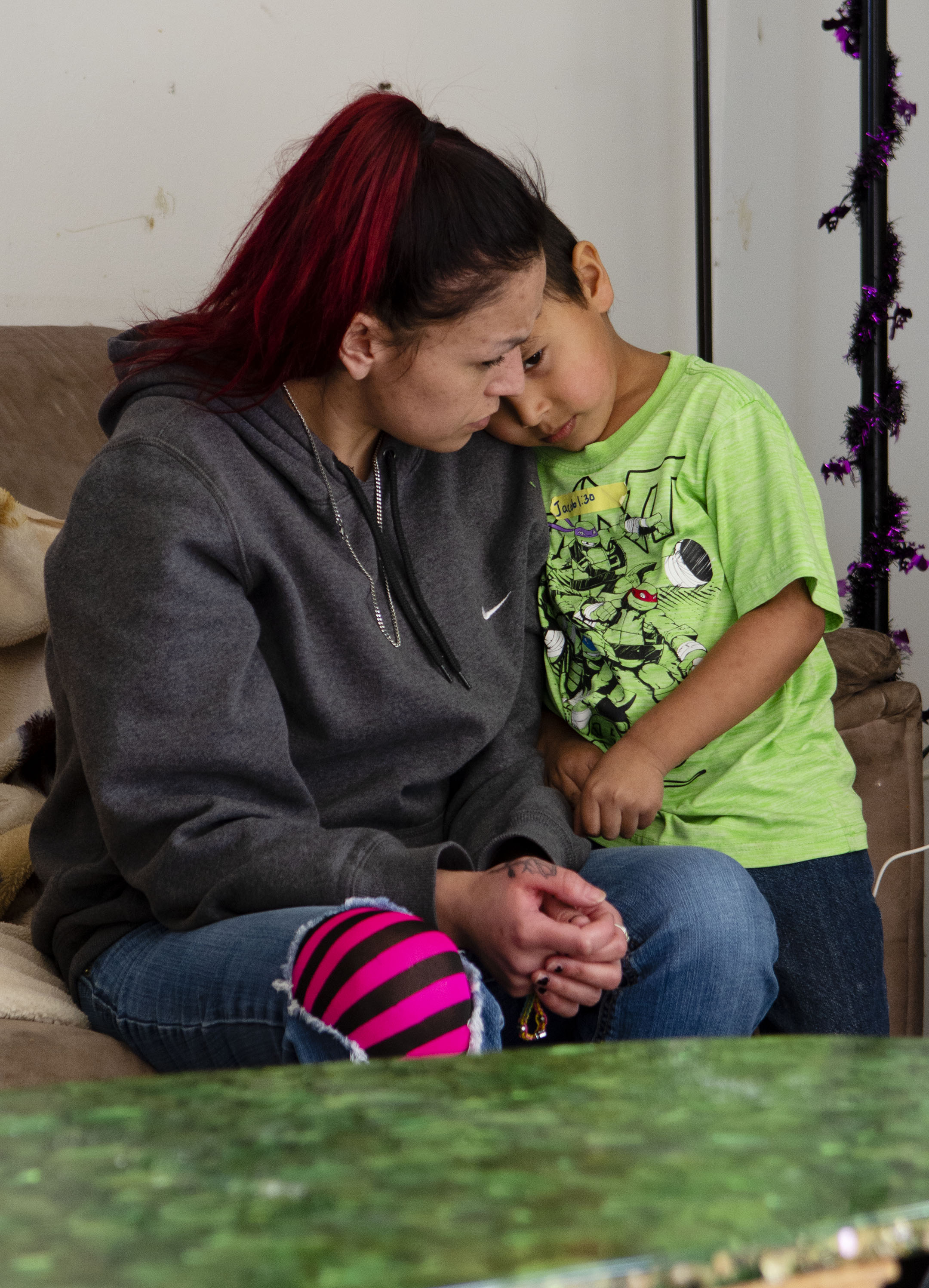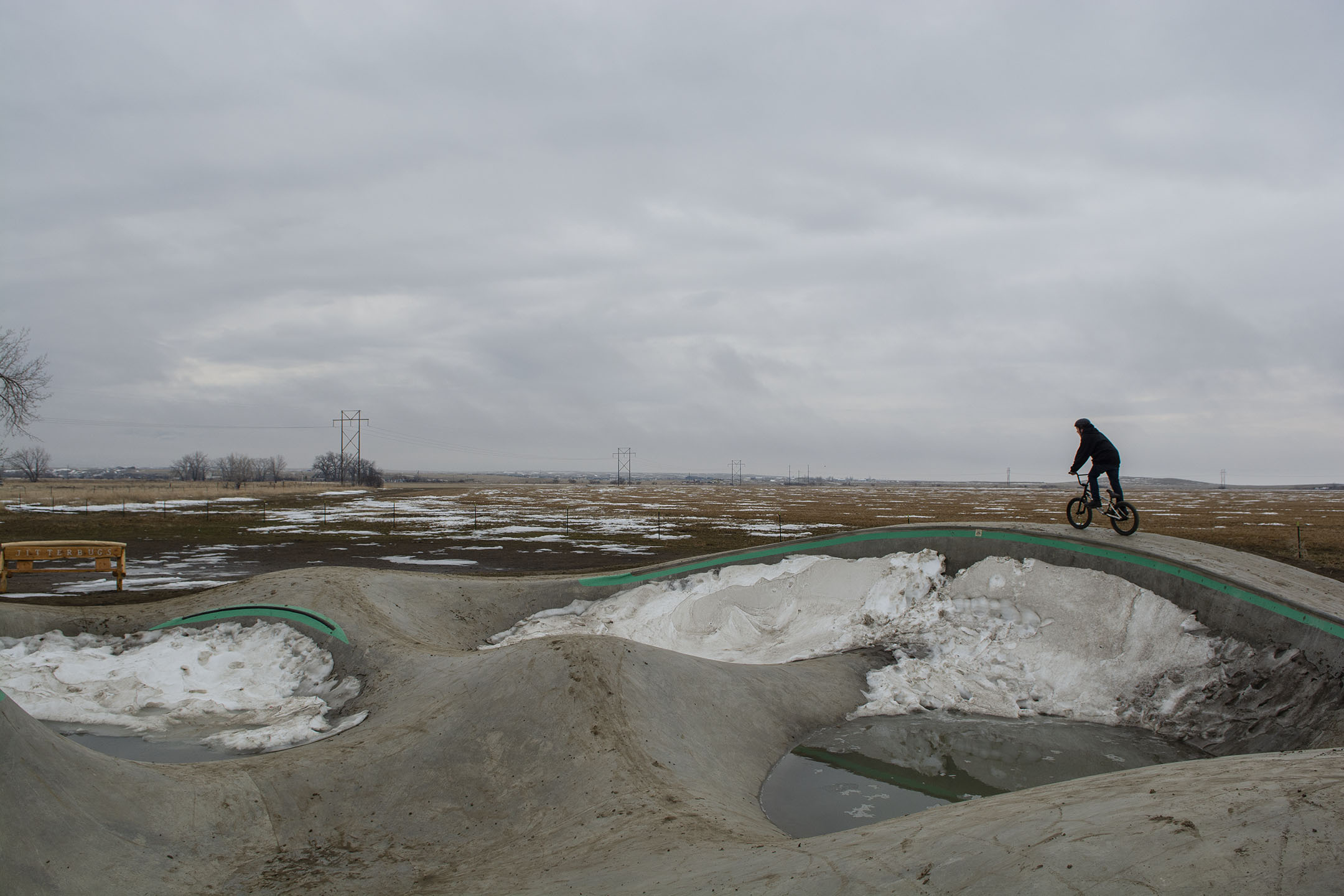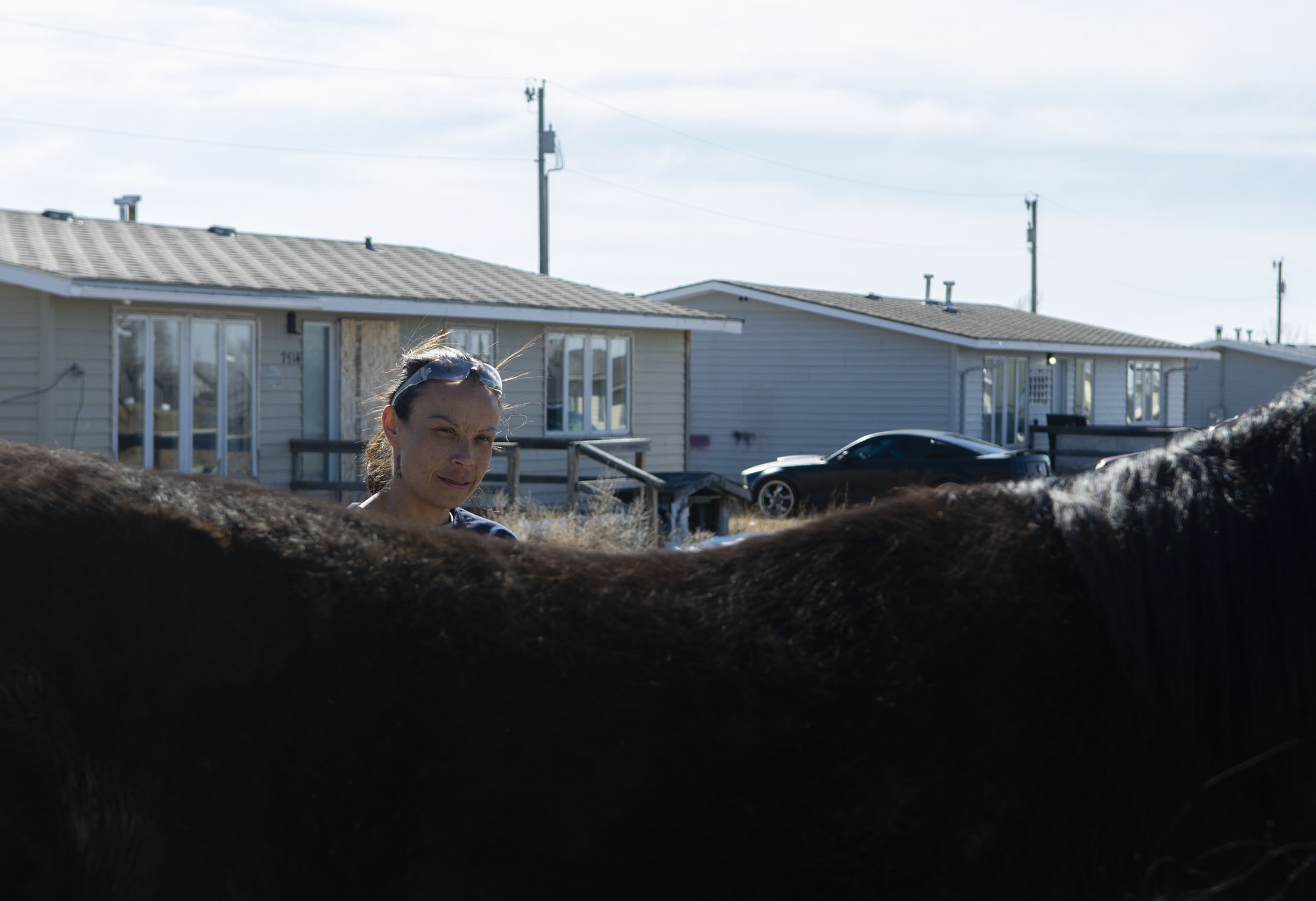Story by Rebecca Keith, photos by Winter Ramos
In the early hours of July 7, 2018, Tasha New Breast-Morrow lay awake on her living room couch. Red and blue flashes lit up the darkness outside her house. She lived close to Box Elder, on Rocky Boy’s Indian Reservation.
She had last seen her best friend, Shannon Licht-Morsette, a couple hours earlier. Licht-Morsette was sitting on the wooden steps across the street in front of her single-story yellow house, waiting for her 14-year-old son to return home on a bus from South Dakota.
“I know that night when it happened, this whole block, I swear it was pitch black,” she said. There were no street lights or porch lights like normal. “I had to use a flashlight to walk outside.”
An hour later, she started getting messages from her friends that something happened to Licht-Morsette. The street was blocked off by police cars and an ambulance. Licht-Morsette’s mom, Marla Boe Morsette, stood by her truck with her grandsons, sobbing.
New Breast-Morrow woke up throughout the night and each time she heard her friend’s mother screaming and crying.
Shannon Licht-Morsette had been murdered.
Licht-Morsette was found dead by her 14-year-old son and his uncle around 1 a.m. Tribal police showed up first. They called the FBI and the Hill County Coroner’s office, who showed up around 2:30 a.m. and examined the body together.
Within hours of her death, Licht-Morsette’s murder investigation involved three different law enforcement agencies: the FBI, Hill County Sheriff’s department and the Rocky Boy Police Department. This is normal for major crimes committed on the reservation. The number of agencies often involved in these crimes can make it difficult for a victim’s family and friends to know where to get information.
In 2018, the Seattle-based Urban Indian Health Institute released a report on Missing and Murdered Indigenous Women and Girls. The report found that jurisdiction issues often lead to misreported numbers as many women are completely overlooked and their tribal nation is often left in the dark.
“Tribal nations must have the ability to advocate for their citizens living in urban areas when they go missing or are killed,” the report states. “This is a courtesy extended to all other sovereign nations … the nation is notified of their death and [they are] able to advocate for their citizen’s case and family.”

New Breast-Morrow and Licht-Morsette lived directly across the street from each other. Both single moms, they had two sons close in age who watched cartoons together while their mothers cooked dinner and listened to old-school rap.
New Breast-Morrow shook her head in disbelief. “She was the kindest person.” Licht-Morsette would have given her last dollar away.
She would spend a lot of nights sleeping on New-Breast Morrow’s couch in their living room with her youngest son. One time, Licht-Morsette put a lighter to her mouth to a light a cigarette, but forgot to put the cigarette in her mouth and accidentally burned herself.
“She was really goofy, like Silly Sally,” New Breast-Morrow said.
New Breast-Morrow sits on that couch now, her hands crossed tightly in her lap, a rose tattoo on each thumb and pink tipped dark hair in a ponytail. Her 5-year-old son empties a cardboard box of Hot Wheels cars on to her green, glass coffee table. He holds one up and talks to her.
“I swear her and her youngest son had their own language. They would talk to each other,” New Breast-Morrow recounts with a laugh because she never could understand what the two were saying.
Later that Saturday, around 11 a.m., the FBI questioned New Breast-Morrow with the tribal police present.
New Breast-Morrow said in a Facebook message that she remembers the FBI leading the questioning and the tribal police observing and mostly listening
The day after, the same tribal police officers came back without the FBI, and asked more questions. This time they surrounded her house, placed her and her children on the couch in the living room and did a search.
According to New Breast-Morrow, an officer told her he drove by her house everyday and saw the accused murderer standing on her porch. New Breast-Morrow told him that wasn’t true and that she never saw police driving by her house. She said he tried to make it seem like she was lying.
According to an article published by the Great Falls Tribune on July 10, 2018, Tribal Police Chief Larry Bernard said that he didn’t know many details about the case and that he had been told to turn the case over to the FBI.
New Breast-Morrow heard nothing for several months. She kept her blinds closed and lived in constant paranoia. Finally in October, she heard about an arrest on Facebook and felt some relief.
Under the Major Crimes Act of 1885, the FBI has the jurisdiction to investigate major crimes on tribal reservations: murder, manslaughter, rape, assault with intent to kill, arson, burglary, and larceny. The list has since been updated to include more crimes such as felony assault, sexual abuse and kidnapping.
This often leaves tribal authorities on the sidelines, watching as outside forces dictate how to investigate crimes that target their own citizens, neighbors and family.
“It’s got a lot to do with communication, talking openly and not being territorial,” said Harlan Baker, tribal council chairman for the Rocky Boy’s Indian Reservation, where Licht-Morsette lived. He said the relationship between the three agencies is not terrible, but it could be much better. It could also get much worse as soon as someone new is in charge of any of the agencies.
The FBI has 35 field agents covering several areas in Montana. The chairman said his tribe has tried to establish a better relationship with the FBI, but they rarely come to the tribal council meetings.
“We invite the FBI to come and sit with us, and they come and sit maybe once every couple years,” Chairman Baker said. Since he began serving on the council in 2008, the longest an agent has stayed in the region was about three years. It seems every year there is a new agent responsible for cases on Rocky Boy’s.
He believes the tribe needs their help more often than the FBI gives, because the tribal law enforcement does not have training to handle more serious cases like abduction and murder, and the tribal courts have limits on the severity of sentences they can give. The department also lacks communication with state law enforcement. They’ve rarely worked together, even though cases often cross borders into state jurisdiction.
Chairman Baker thinks that written protocols for multiple jurisdictions collaborating on cases would be important so the agencies consistently work together.
The council has considered measures to allow more severe sentences in tribal courts, but have yet to actually propose tribal legislation governing communication with other law enforcement agencies.

In Licht-Morsette’s case, the tribal police believed that the murderer was hiding in New-Breast Morrow’s house, but they gave no indication during the FBI interview that they suspected she was hiding him. The FBI only questioned New Breast-Morrow about the people who were over at Licht-Morsette’s house, the night she died.
Licht-Morsette’s eldest son was coming back to his mom’s house after being gone for a month. According to the affidavit, he texted her around 12:20 a.m. on July 7, 2018. Forty minutes later, he walked into their house and found his mother lying on the floor in her bedroom. There were red scratches on her neck and a bite mark in her left arm. Shattered picture frames lay around her legs. His 1-year-old brother was in the house with her.
Her son was friends with another teenager in the village, Elena Garcia’s son. Garcia’s ex, Brandon Sutherland, was staying with her that weekend, along with his brother Gavin Sutherland, Adam Swan, and Lynnell Boldt. Garcia lived a couple blocks down from Licht-Morsette.
With all of them staying at her house, she couldn’t stand being around the four of them and left early in the day, Garcia said. She said they were all acting strange, and saying weird things, especially Gavin Sutherland.
“I don’t know if it was because he stayed awake too long and he started to see stuff and hear stuff. But I think maybe that’s why he was kinda going crazy,” Garcia said. It made her nervous.
Garcia was just getting to be good friends with Licht-Morsette.
“She was always nice even though me and her weren’t that close, we would always come down and borrow coffee and whatever,” Garcia said. When the two finally both had coffee, missing sugar would send them back to each others’ houses.
The Sutherland brothers, Swan and Boldt, went over to Licht-Morsette’s house to hang out that day. The last time Garcia saw her, she said she wished the people in her house would leave because her son was coming home.
“She was so nice to everyone, she was too nice to tell them people to leave,” Garcia said.
Garcia found out about Licht-Morsette’s death on Facebook. That’s how most news of missing and murdered Native American women is spread.
Native American women go missing at far higher rates than any other race in Montana. According to the Department of Justice, Native American women make up more than 30 percent of female missing persons reports filed in Montana in the last three years. Native Americans make up just under 7 percent of the population of Montana. Most of them don’t live on reservations, falling under state jurisdiction.
Data from the department confirms what Native American communities have been saying for decades, their women are being targeted. But this number does not grasp the true scope of the problem.
Data from the Sovereign Bodies Institute puts the number of Native American women still missing in Montana in the past three years at 35. The Department of Justice puts the number at 15. The institute, run by Native Americans, gathers data from law enforcement, but also by aggregating information from Facebook pages and on-the-ground reporting with families. The institute puts the total number of unresolved cases in Montana at 66 in the last three years.
In its 2018 report, the Urban Indian Health Institute used both official Freedom of Information Act Requests and grassroots reporting to compile data of missing and murdered Native American women. The report found 153 cases of missing and murdered Native American women nationwide that were not in law enforcement data bases. Great Falls had five cases that are not located in law enforcement records, which is the 10th highest rate of any city in the country.
Billings was ranked second, with 17 cases.
“Some cities still do not have systems that are searchable by race or include American Indian, Native American as categories,” the report states, calling for cities to update their record keeping tactics. “No agency can adequately respond to violence it does not track.”
The difference between data from the Sovereign Bodies Institute and the Department of Justice’s data, further shows the confusion between Native American tribes in Montana and the law enforcement agencies responsible for recovering their loved ones. At least 20 Native American girls have gone missing in Montana in the last three years without ever being recorded by responding law enforcement agencies.
“We wish for quicker responses,” Baker said.

Baker hasn’t heard anything about Licht-Morsette’s case from the FBI since they came to the reservation to investigate the night of the murder. He heard about the murder charges being filed from a local TV news station.
When he was younger, he remembers hearing about the prejudice and racism in the FBI. He’d hear people say that the federal agencies didn’t want to come onto the reservation.
“If they don’t want to work with us, is it still that kind of mentality? Possibly.” Baker said. “Their actions speak louder than their words so if they don’t wanna work with us there is something going on besides the lack of communication.”
In December 2018, the Congressional Committee on Indian Affairs held a hearing on the problem of missing and murdered women in Indian Country. Montana Senator John Tester invited several Native Americans with missing family members to speak in front of the committee.
They detailed a lack of response and communication from state and federal agencies alike. And even when the agencies did track down a suspect, the evidence was too sparse to prosecute.
Representatives from the BIA, the FBI, and the Office of Investigative and Forensic Sciences at the National Institute for Justice were present to testify. They described their procedures when dealing with crimes in Indian Country, but all the families who had firsthand experience with the agencies testified that what they said at the hearing and what they did on the ground did not match.
“This is your failure,” said Heidi Heitkamp, a former senator from North Dakota. “When you don’t have prosecution, you have no deterrents and it’s open season on people who live in Indian Country.”
It took the FBI several months to put together evidence to arrest a suspect in Licht-Morsette’s murder. Even then, the suspect was arrested in Washington on unrelated charges and confessed to the murder when questioned by FBI agent David Brown.
According to the affidavit written by Agent Brown, the evening Litch-Morsette was murdered, she had guests she wished would leave and she confronted Gavin Sutherland about some money of hers that was suddenly missing. She and Sutherland went into her room. Then she screamed.
“It was the sound a woman makes when she gets hit … or when she’s scared,” Boldt said in the affidavit.
According to the affidavit, Sutherland confessed to hearing voices and seeing a shadow while he was talking to Licht-Morsette, and they told him to kill her, so he strangled her.
He was arrested on Oct. 10, 2018, and charged with second degree murder and is currently in the custody of U.S. Marshals. Sutherland pleaded not guilty to one count of second degree murder and a jury trial is scheduled for May 13, 2019.
Licht-Morsette’s neighborhood is at the western edge of the reservation. Snow on the distant Bear’s Paw Mountains has melted in ribbons. Spots of evergreen and aspen trees dot the mountains.
At the very end of the road, next to New Breast-Morrow’s and across from Licht-Morsette’s, is Leno Jo Henderson’s house. The three of them were the closest of friends. The Henderson’s have an old wedding arch made of aspen wood over their steps. Their two horses, one black and one palomino, fuzzy from the winter, live in the field next to them.

Henderson stands in front of New Breast-Morrow’s open door in pajama pants, holding a fuzzy white cat with brown spots.
Henderson is tall, with her dark hair pulled back in a half ponytail and smile lines on her face. In her soft voice she talks about how they just finished up a month long stretch of below freezing weather, so they’re all going a little stir crazy. Her husband helped all the houses on the street with fire wood. They had to burn the wood they had set aside for a barn.
Two of their cats run across the street and behind Licht-Morsette’s house, which is still empty.
She said it took a long time for the housing authority to come out and put plywood over the front door. Their littlest kids kept going inside the house looking for Aunt Shanni.
Henderson wishes they would find someone to rent the house to already. “Get rid of the darkness inside,” she said.
